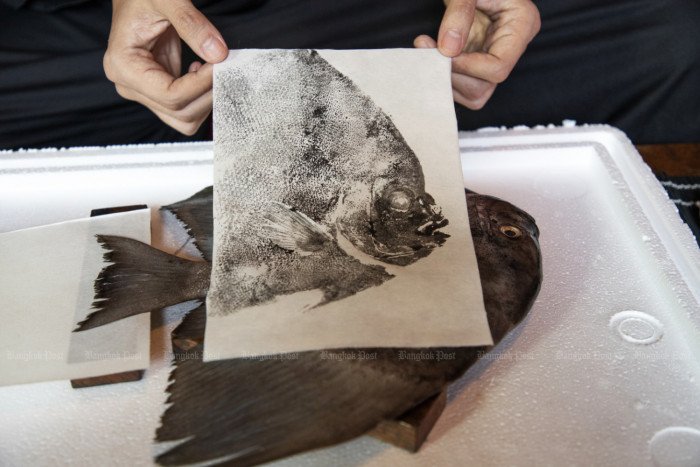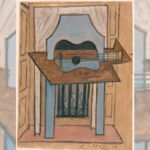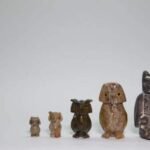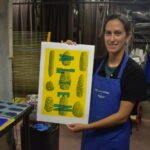
Gyotaku, or fish printing, was a traditional method used by Japanese fishermen to record their catches before photography existed. Centuries ago, the practice was roughly done by using natural ink, such as squid ink, applied on the fish, then pressing it with a piece of paper or fabric found on the boat.
The printing images were once seen merely as a way for fishermen to show others their prizes from the sea. Over time, the intricate ridges and scales, depicted in a completely different way from photographs, were revered as an art form. This printing technique was developed and valued by Japanese aristocrats.
With its life-like imprints, the craft has captivated worldwide art enthusiasts, including Jaturun “Thank” Rungruengsaowapak, one of the few gyotaku artists in Thailand.

Thai gyotaku artist Jaturun “Thank” Rungruengsaowapak.
The 31-year-old said he first saw gyotaku hanging on a restaurant wall, and its outstanding beauty made him wonder how it was created.
“I had to learn it by translating texts from Japanese or English as there was hardly any information in Thai at the time,” Thank said, recalling his introduction to gyotaku three years ago.
Thank also owns a bar in Bangkok where fish sashimi is served.
“I’m crazy about the diversity of fish,” he said. “My key goal is to print all Thai fish species.”

The artist pats the fish dry and applies sumi ink on it. This time, he chose teira batfish, or platax, a tropical species with its wing-like fins.
The process began by drying off the fish’s surface as much as possible, since any remaining moisture would make it difficult to control the ink during painting.
The black ink used for gyotaku is called sumi, which is also used in Chinese calligraphy. Sumi ink, made of pine cones or fish skin, is food-safe, allowing the fish to be processed for eating afterwards.
Shading techniques vary by artist when applying ink to the fish, Thank explained, saying his preference was to depict the fish as close to reality as possible, so he applied more ink to patterned areas and less to plain parts.
The traditional Japanese paper used for gyotaku is called washi. In Thailand, however, there is mulberry paper, known as saa paper, which Thank said offers similar quality.
With steady hands, the craftsman pressed the paper onto the fish, gently guiding each finger along its ridges and scales. Flipping the paper revealed the printed image as if the fish had drawn itself, while the final step was to add an eye, the only feature drawn by the artist.


Nowadays, gyotaku also serves as an educational activity, helping children learn basic marine anatomy.
“Beyond being caught and cooked, the fish lives on in the art,” the Thai gyotaku artist said.
His works and live printing are now featured in the Thailand Printmaking Festival being held at Central Chidlom, Bangkok, running until July 15 on the second floor’s event hall.
Discover more about the artist’s ink journey in the interview video by the Bangkok Post below.









